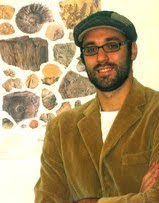Welcome to the Geology in Art blog!
The role of geology in art is mercurial, and is somehow mysterious.
Indeed geology and art are inextricably bound together. The science and art of geology have developed in concert and they are still interdependent ways to describe nature.
Through this blog I will discuss the relationship between geology in art, covering painting, literature, comics, photography, sculpture, conceptual art, music, cinema, theatre, dancing...are you ready?
This blog is intimately bound to "Geology in Art: an unorthodox path from visual arts to music", the first book to document the artistic phenomena in which geology brings its own aesthetic and conceptual heritage. Many of the topics discussed in this blog are coming from the mentioned work. If you feel intrigued by the "geology and art" theme, don't miss this book!
The first issue of this blog/web-zine aims to give a sense of the possibilities that may emerge when geology becomes a central theme in art. The four contributions in this issue offer different perspectives on the role of Geology in Art. Enjoy!
The role of geology in art is mercurial, and is somehow mysterious.
Indeed geology and art are inextricably bound together. The science and art of geology have developed in concert and they are still interdependent ways to describe nature.
Through this blog I will discuss the relationship between geology in art, covering painting, literature, comics, photography, sculpture, conceptual art, music, cinema, theatre, dancing...are you ready?
This blog is intimately bound to "Geology in Art: an unorthodox path from visual arts to music", the first book to document the artistic phenomena in which geology brings its own aesthetic and conceptual heritage. Many of the topics discussed in this blog are coming from the mentioned work. If you feel intrigued by the "geology and art" theme, don't miss this book!
The first issue of this blog/web-zine aims to give a sense of the possibilities that may emerge when geology becomes a central theme in art. The four contributions in this issue offer different perspectives on the role of Geology in Art. Enjoy!
Andrea Baucon
www.geologyinart.com
- Geology and painting: Leonardo da Vinci
Leonardo da Vinci is universally regarded as one of the pioneers of Earth sciences for having recognized and interpreted a number of geologic phenomena. In his famous notebooks da Vinci focused on sedimentary geology and discussed sedimentation, stratification and fossils. Less well known is the fact that Leonardo expressed his revolutionary geologic theories in his paintings. Leonardo represented stratification in its finest details, including small-scale laminations. Can you find them? (start the video at 1:50)
- Geology and land art: Spiral Jetty
Land art is a movement in which landscape and the work of art are inextricably linked. Land art and geology are bound together, as geology is the science of the landscape. The video shows "Spiral Jetty", a work by Robert Smithson. The artist chose the site for the blood-red color of the waters and its connection with the primordial sea. "Spiral Jetty" is built of mud, salt crystals, basalt, earth and water.
- Geology in music: earthquake sonification
Geologic sonification is probably the most direct form of interaction between geology and sound. Sonification translates quantitative data into sound, being the acoustic counterpart of graphic data visualization.
Photography appears persistently in scientific geology as it creates pictures of geologic features by recording their light radiation on sensitive media.
Therefore it is no surprise that geologic themes and photographers are commonly featured in artistic photography. This is the case of Michael Collier who for 20 years has been taking aerial photographs of the Earth's geology.
- Geology in literature and cinema: Journey to the Centre of the Earth
Jules Verne's “Journey to the Centre of the Earth” has some serious scientific inconsistencies, but it also reveals the author’s remarkable geologic background. According to a brillant paper by Breyer and Butcher, much of the scientific information in Verne’s novel was taken directly from Figuier’s “La Terre avant le déluge” (“The World before the Deluge”), a popular science book that was a best-seller in Verne’s time.
- Geology and photography
Photography appears persistently in scientific geology as it creates pictures of geologic features by recording their light radiation on sensitive media.
Therefore it is no surprise that geologic themes and photographers are commonly featured in artistic photography. This is the case of Michael Collier who for 20 years has been taking aerial photographs of the Earth's geology.






No comments:
Post a Comment